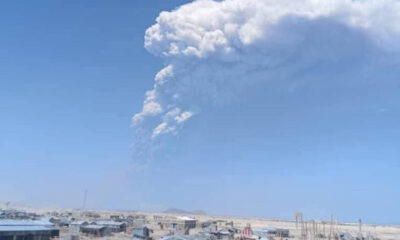Business
SpaceX loses Starship but successfully recovers booster during test flight

A SpaceX test of its Starship launch vehicle resulted in the loss of the spacecraft but successfully recovered the booster, the company reported. Debris from the spacecraft briefly led to ground stops at several Florida airports.
Starship Flight 8 lifted off at 5:30 p.m. CT, with the Super Heavy booster firing all 33 of its Raptor engines to propel the vehicle through a nominal first-stage ascent, SpaceX said in a statement. Starship then successfully separated from the booster to continue its ascent.
Following separation, the Super Heavy booster relit 11 of its planned 13 Raptor engines and performed a boostback burn to return to the launch site. The booster successfully landed in the launch and catch tower arms, marking the third successful catch of a Super Heavy booster.
Starship continued its ascent to its planned trajectory. However, before completing its ascent burn, an energetic event in the aft portion of Starship caused the loss of several Raptor engines, SpaceX stated. This led to a loss of attitude control.
“The vehicle experienced a rapid unscheduled disassembly and contact was lost,” SpaceX said. “Our team immediately began coordination with safety officials to implement pre-planned contingency responses.”
The Federal Aviation Administration (FAA) issued temporary ground stops at Miami International Airport, Orlando, Palm Beach, and Fort Lauderdale on Thursday evening due to Starship debris. The FAA says it is “requiring SpaceX to perform a mishap investigation,” according to CNN.
Debris from Starship was observed over southern Florida, the Bahamas, the Dominican Republic, and Turks & Caicos, according to witness videos.
A previous test in January resulted in the loss of Starship Flight 7, but also marked the second successful recovery of the booster. Similarly, debris from that launch vehicle was seen streaking across the skies in the Caribbean.
Starship is SpaceX’s fully reusable launch system designed to carry both crew and cargo to destinations including the Moon and Mars. Standing nearly 400 feet tall, the vehicle consists of two stages: the Super Heavy booster, which provides initial thrust, and the Starship upper stage, which continues the journey beyond Earth’s atmosphere. Unlike traditional rockets, both stages are intended to be recovered and reused, significantly reducing launch costs.
“With a test like this, success comes from what we learn, and today’s flight will help us improve Starship’s reliability,” said SpaceX.

-

 World1 week ago
World1 week agoEthiopian volcano erupts for first time in thousands of years
-

 Legal5 days ago
Legal5 days agoUtah Amber Alert: Jessika Francisco abducted by sex offender in Ogden
-

 US News4 days ago
US News4 days agoExplosion destroys home in Oakland, Maine; at least 1 injured
-

 Health5 days ago
Health5 days agoMexico’s September human bird flu case confirmed as H5N2
-

 World5 days ago
World5 days agoWoman killed, man seriously injured in shark attack on Australia’s NSW coast
-

 Legal1 day ago
Legal1 day ago15 people shot, 4 killed, at birthday party in Stockton, California
-

 Health4 days ago
Health4 days agoMarburg outbreak in Ethiopia rises to 12 cases and 8 deaths
-

 US News4 days ago
US News4 days agoEarthquakes rattle area between Salinas and Hollister, California




